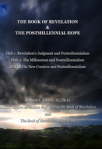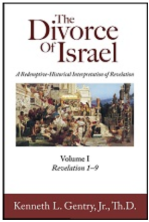OBJECTIONS TO NERO
 PMW 2024-065 by Kenneth L. Gentry, Jr.
PMW 2024-065 by Kenneth L. Gentry, Jr.
Our study of 666 as a reference to Nero, though widely held, is not accepted by all scholars. There are certain problems that some see with the Nero designation. I will mention two of the major ones.
The Silence of Early Church Fathers
It is frequently argued that in one of the earliest treatments of Revelation 13 there is no mention of Nero as a likely candidate. The reference to which we refer was written by Irenaeus, Bishop of Lyons, around A.D. 180.
Not only does Irenaeus not mention Nero, but he mentions other possibilities: Euthanos, Laetinos, and Teitan. [1] If Nero was the actual meaning of the riddle, why did not Irenaeus know this, since he wrote about the matter 100 years later? Why do no other church fathers suggest it?
This would certainly appear to be a reasonable objection to our theory. In fact, it is the strongest argument against it. However, in the final analysis it cannot overthrow the positive evidence for the theory, for two reasons.
First, this argument is really a two-edged sword. The very fact that Irenaeus, writing just 100 years after Revelation, cannot be sure of the proper designation demonstrates that the true interpretation, whatever it was, had very quickly been lost. If this is true of Irenaeus in A.D. 180, it is certainly true of the later fathers.
Second, had Irenaeus offered with conviction and assurance a specific alternative, the case against the Nero theory would have been more seriously challenged. Interestingly, Irenaeus suggests the hopelessness of determining the proper understanding:
“It is therefore more certain, and less hazardous, to await the fulfillment of the prophecy, than to be making surmises, and casting about for any names that may present themselves, inasmuch as many names can be found possessing the number mentioned; and the same question will, after all, remain unsolved.” [2]
Irenaeus admits his own ignorance on the matter. How can that prove the Nero theory wrong? None of the later church fathers does more than guess at the solution. Did the riddle have no answer?
 The Book of Revelation and Postmillennialism (Lectures by Ken Gentry)
The Book of Revelation and Postmillennialism (Lectures by Ken Gentry)
In the first of these three 50-minute lectures Gentry explains Revelation’s judgments to show they do not contradict postmillennialism. In the next two lectures he shows how the Millennium and the New Creation themes strongly support the gospel victory hope found in postmillennialism.
See more study materials at: www.KennethGentry.com
The Problem of the Hebrew Spelling
Some have argued that since John writes to Gentile churches in Asia Minor, the mechanics of deriving the name from its Hebrew spelling would be too difficult for the audience. Though reasonable at first glance, this objection also fails to undermine the Nero view.
First, although John wrote in Greek, Revelation has long been recognized as one of the more “Jewish” books of the New Testament. All technical commentaries on Hebrew recognize this.
For instance, in his commentary late-date proponent R. H. Charles included a major section entitled “A Short Grammar of the Apocalypse.”. Section 10 of this “Grammar” is entitled “The Hebraic Style of the Apocalypse”. [3] There Charles well notes that “while [John] writes in Greek, he thinks in Hebrew.” [4] As J. P. M. Sweet puts it:
“The probability is that the writer, thinking in Hebrew or Aramaic, consciously or unconsciously carried over Semitic idioms into his Greek, and that his ‘howlers’ are deliberate attempts to reproduce the grammar of classical Hebrew at certain points.” [5]
Second, in fact there are other very Hebraic names in Revelation. For instance, the Hebrew words “Abaddon” (Rev. 9:11) and “Armageddon” (Rev. 16:16) are carefully given Greek equivalents. The Hebrew word “Satan” is interpreted into Greek as “the devil” (Rev. 12:9).
Other Hebrew words appear, as well: “amen” is said to mean “truthfully” (Rev. 3:14). The Hebrew “hallelujah” is not even translated into a Greek equivalent (Rev. 19:1, 3 , 4, 6). How natural, it would seem, to adopt a Hebraic spelling for the basis of the cryptogram.
Third, Asia Minor was well populated by Jews. Late-date scholar H. B. Swete noted that “[l]ong before the Christian era the Jews had formed a considerable factor in the population of the Asian cities”. [6] Noted church historian Williston Walker writes of the Jews in the first century: “They were a notable part of the population of Alexandria. They were strongly rooted in Syria and Asia Minor . . . . Few cities of the empire were without their presence.” [7] The audience could well have been composed of at least a significant minority of Jews.
BEFORE JERUSALEM FELL
Doctoral dissertation defending a pre-AD 70 date for Revelation’s writing (459 pp; paperback). Thoroughly covers internal evidence from Revelation, external evidence from history, and objections to the early date by scholars.
For more study materials: https://www.kennethgentry.com/
And why should John not use an Hebraic riddle? Was not John himself a Jew? Was not he, the writer of Revelation, sent “to the circumcised” (Gal. 2:9)?
Despite the brevity of each of the Seven Letters, in them are prominent allusions to Jewish situations (Rev. 2:9, 14; 3:9). In the book itself are very definite allusions to Jewish matters, such as the twelve tribes of Israel (Rev. 7 and 14).
Conclusion
The role of Nero Caesar in Revelation is written large. As all roads lead to Rome, so do they all terminate at Nero Caesar’s palace. The factors pointing to Nero in Revelation are numerous and varied. It is difficult to discount the many ways in which Nero fits the expectations of Revelation. He is the only contemporary historical figure that can possibly fulfill all of the requirements. Contrary to some commentators who fear the that the key to Revelation’s “666” is lost, we suggest that the key is actually in the keyhole, the last place to look!
Surely Nero’s specter haunts the pages of Revelation. That being the case, we have a sure terminus for the book’s time of writing: June, A.D. 68 the year of Nero’s death. This fits well with all the other avenues explored thus far.
NOTES
1. Irenaeus, Against Heresies 5:30:3.
2. Against Heresies 5:30:3.
3. R. H. Charles, The Revelation of St. John (Edinburth: T and T Clark, 1929), 1:cxvii, cxlii.
4. Charles, Revelation, cxliii.
5. J. M. Sweet, Revelation (Philadelphia: Westminster, 1979), 16.
6. Swete, Revelation, lxvi.
7.Williston Walker, A History of the Christian Church (3rd ed: New York: Scribner’s, 1970), 16.
The Divorce of Israel: A Redemptive-Historical Interpretation of Revelation
This long-awaited commentary has now been published. It is an 1800 page, two-volume deeply exegetical, academic commentary on the Bible’s most mysterious book.
Click: https://www.kennethgentry.com/the-divorce-of-israel-2-vols-by-gentry-pre-publication-offer/
See more study materials at: www.KennethGentry.com
Kenneth L. Gentry Jr.'s Blog
- Kenneth L. Gentry Jr.'s profile
- 85 followers



